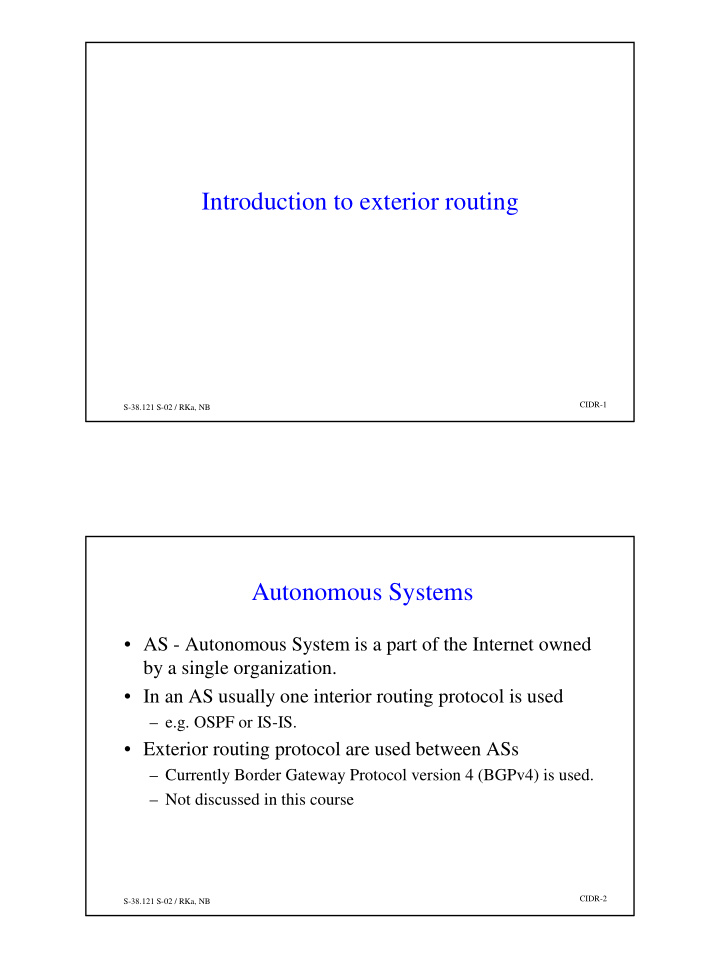



Introduction to exterior routing CIDR-1 S-38.121 S-02 / RKa, NB Autonomous Systems • AS - Autonomous System is a part of the Internet owned by a single organization. • In an AS usually one interior routing protocol is used – e.g. OSPF or IS-IS. • Exterior routing protocol are used between ASs – Currently Border Gateway Protocol version 4 (BGPv4) is used. – Not discussed in this course CIDR-2 S-38.121 S-02 / RKa, NB
Organization of the Internet as Autonomous Systems Route Server Route Server NAP Default-free provider Internet Exchange Customer Default-free provider relationship Midlevel providers Midlevel providers Dial-up providers Dial-up Company Company providers Peering agreement between providers on the same level define exchange of routing information CIDR-3 S-38.121 S-02 / RKa, NB History of the Internet Core …..1985 Arpanet …..1987 NSFNET 56k lines …..1992 NSFNET T1 lines (1.5M) …. 1995 NSFNET T3 lines (24M) 1995 NSFNET decommissioned 1995… Commercial (UUNET,MCI, Sprint... CIDR-4 S-38.121 S-02 / RKa, NB
Internet Addresses are assigned by a hierarchy of registrars IANA Internet Assigned Number Authority RIPE NCC /Europe • This model leads to provider InterNIC /USA addressing. APNIC /Asia Pacific • Due to Provider addressing an ISP needs to advertise shorter prefixes Internet Service Provider a leading to savings in routing table ISP b size in the Backbone ISP x Corporation a , b , z CIDR-5 S-38.121 S-02 / RKa, NB CIDR - Classless Inter-Domain Routing CIDR-6 S-38.121 S-02 / RKa, NB
CIDR - Classless Inter Domain Routing • Problems caused by the growth of the Internet – Not enough B-class addresses • Class A is too big, class C too small (256 addresses) • Only 16384 class B networks – Addresses in class B are used inefficiently • Class B is usually too big too (65534 addresses) – Growth of routing table size • Internet growth has forced the adoption of CIDR address arithmetic to improve the efficiency of using IP address space. • CIDR was adopted 1992 • CIDR affects most routing protocols CIDR-7 S-38.121 S-02 / RKa, NB CIDR allows splitting 32-bit IP-addresses freely into prefix and tail MSB Network Host A 0 7 bits 24 bits B 10 14 bits 16 bits 21 bits 8 bits 110 C IP-prefix Subnet + host • A sequence of C class networks can be represented: 194.51.120.0 - 194.51.127.255 = start = 194.51.120.0 mask = 255.255.248.0 CIDR-8 S-38.121 S-02 / RKa, NB
Repetition: address arithmetics • Example 192.24.134.23 address AND 255.255.248.0 mask 192.24.128.0 network 192.24.134.23 address – 192.24.128.0 network 0.0.6.23 host 192.24.143.23 address (alternative way) AND 0.0.7.255 NOT (mask) 0.0.6.23 host CIDR-9 S-38.121 S-02 / RKa, NB CIDR changes the way routes are advertised • Rule 1: – Routing always looks for longest match address with the destination. � addresses of multi-homed networks can not be aggregated. (multi-homed network connects to many ASs.) • Rule 2: – A network that aggregates a set of routes must delete packets that match with the aggregated prefix but with none of the network addresses that went into the aggregate. This helps to avoid loops. CIDR-10 S-38.121 S-02 / RKa, NB
Example (1) • Customers of the ISP ≤ 2048 addresses – A1: (8 class C networks) • 192.24.0 – 192.24.7 192.24.0.0 / 255.255.248.0 ≤ 1024 addresses – A2: (4 class C networks) • 192.24.8 – 192.24.11 192.24.8.0 / 255.255.252.0 ≤ 1024 addresses – A3: (4 class C networks) • 192.24.12 – 192.24.15 192.24.12.0 / 255.255.252.0 ≤ 4096 addresses – A4: (16 class C networks) • 192.24.16 – 192.24.31 192.24.16.0 / 255.255.240.0 ≤ 512 addresses – A5: (2 class C networks) • 192.24.32 – 192.24.33 192.24.32.0 / 255.255.254.0 ≤ 512 addresses – A6: (2 class C networks) • 192.24.34 – 192.24.35 192.24.34.0/255.255.254.0 CIDR-11 S-38.121 S-02 / RKa, NB Example (2) • Customers of the ISP ≤ 2048 addresses – A1: (8 class C networks) • 192.24.0 – 192.24.7 192.24.0.0 / 255.255.248.0 ≤ 1024 addresses – A2: (4 class C networks) • 192.24.8 – 192.24.11 192.24.8.0 / 255.255.252.0 ≤ 1024 addresses – A3: (4 class C networks) • 192.24.12 – 192.24.15 192.24.12.0 / 255.255.252.0 ≤ 4096 addresses – A4: (16 class C networks) • 192.24.16 – 192.24.31 192.24.16.0 / 255.255.240.0 ≤ 512 addresses – A5: (2 class C networks) • 192.24.32 – 192.24.33 192.24.32.0 / 255.255.254.0 ≤ 512 addresses – A6: (2 class C networks) • 192.24.34 – 192.24.35 192.24.34.0/255.255.254.0 CIDR-12 S-38.121 S-02 / RKa, NB
Example (3) A1 AS (A) 192.24.0.0 - 192.24.7.x 192.24.0.0/255.255.248.0 A2 A3 192.24.8.0 – 192.24.11.x 192.24.12.0 - 192.24.15.x 192.24.8.0 / 255.255.252.0 192.24.12.0/255.255.252.0 A A4 192.24.0.0 192.24.16.0 - 192.24.31.x - 192.24.16.0/255.255.240.0 192.31.x.x A5 A6 192.24.32.0 - 192.24.33.x 192.24.34.0 - 192.24.35.x 192.24.32.0/255.255.254.0 192.24.34.0/255.255.254.0 A: 192.24.0.0/255.248.0.0 Backbone CIDR-13 S-38.121 S-02 / RKa, NB Example (4) • Assuming that there is another AS (B) – Network 192.32.0.0 / 255.248.0.0 • A3 and A5 are attached to two ASs – A3 is primarily advertised through A – A5 is primarily advertised through B • A7 has moved AS (A) � AS (B) – Network 192.32.0.0 / 255.255.240.0 CIDR-14 S-38.121 S-02 / RKa, NB
Example (5) A7 A1 AS (A) 192.32.0.0 - 192.32.15.x 192.24.0.0 - 192.24.7.x 192.32.0.0/255.255.240.0 192.24.0.0/255.255.248.0 A2 A3 192.24.8.0 – 192.24.11.x 192.24.12.0 - 192.24.15.x 192.24.8.0 / 255.255.252.0 192.24.12.0/255.255.252.0 A A4 B 192.24.0.0 “192.32” AS(B) 192.24.16.0 - 192.24.31.x - 192.24.16.0/255.255.240.0 192.31.x.x A5 A6 192.24.32.0 - 192.24.33.x 192.24.34.0 - 192.24.35.x 192.24.32.0/255.255.254.0 192.24.34.0/255.255.254.0 A3: 192.24.12.0/255.255.252.0 A3: 192.24.12.0/255.255.252.0 A7: 192.32.0.0/255.255.240.0 A5: 192.24.32.0/255.255.254.0 A: 192.24.0.0/255.248.0.0 B: 192.32.0.0/255.248.0.0 Backbone CIDR-15 S-38.121 S-02 / RKa, NB Protocols that support CIDR • Exterior protocols – Support: BGP-4 – No support: EGP, BGP-3 • Interior protocols – Support: RIP II, OSPF, E-IGRP – No support: RIP, IGRP CIDR-16 S-38.121 S-02 / RKa, NB
Network Address Translation (NAT) preserves address space and improves security Network Address Translation Public NAT Intranet Internet Non-unique addresses • 10/8 • 172.16/12 • 192.168/16 � Not routable in public Internet CIDR-17 S-38.121 S-02 / RKa, NB
Recommend
More recommend